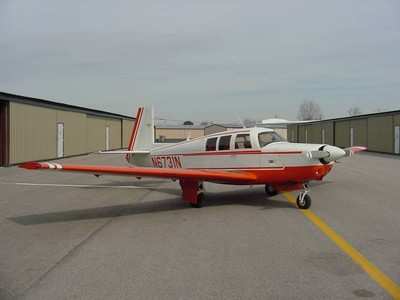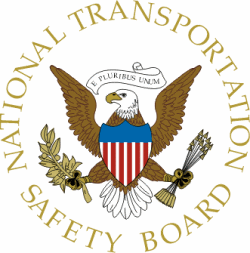Winds At The Uncontrolled Airfield Reported Calm At The Time, Three Fatally Injured
Three people were fatally injured in July when a Mooney M20F went down after executing a missed approach to an uncontrolled airport in North Elba, NY. The transient pilot of the Mooney was apparently trying to avoid another, locally-based airplane that was approaching the same runway from the opposite direction, and stalled on the missed approach.

According to the preliminary report, on July 19, 2014, about 1040 eastern daylight time, a Mooney M20F, N6467Q, was destroyed when it impacted terrain in North Elba, New York. The private pilot and two passengers were fatally injured. Visual meteorological conditions prevailed. The airplane was not operating on flight plan, from Potsdam Municipal Airport (PTD), Potsdam, New York, to Lake Placid Airport (LKP), Lake Placid, New York. The personal flight was conducted under the provisions of 14 Code of Federal Regulations Part 91.
New York State Police (NYSP) interviews revealed that, on July 17, 2014, the pilot and his girlfriend originally departed their home airport in Parkersburg, West Virginia, spending the night in Nantucket, Massachusetts. They then arrived at PTD on the afternoon of July 18, 2014, intending to spend the next two nights visiting his daughter who was attending a local university. The pilot and his daughter decided to fly the next day, with the daughter bringing a friend from school. After dinner, the pilot familiarized himself online with the area, and the day of the accident left the hotel about 0900, with his daughter and her friend, expecting to return between 1400 and 1500.
LKP has a single, southeast-northwest, 4,196-foot by 60-foot runway, designated 14 to the southeast and 32 to the northwest. Runway elevation was 1,743 feet, and there was no control tower. The UNICOM (Universal Communications) frequency was 122.8 MHz.
According to a charter pilot at LKP, he was outside the administration building when he heard a radio transmission over the loud speaker, with the pilot identifying himself as "Mooney" and the last three identifiers of his airplane. The Mooney pilot was requesting an airport "advisory, which is normal procedure." The charter pilot went inside and advised the Mooney pilot that "the winds were calm and no other reported traffic." The Mooney pilot responded and said that he was inbound for landing on runway 14.
The charter pilot went back outside and later overheard the Mooney pilot on the loud speaker saying he was seeing another airplane. The Mooney pilot was trying to talk to the other airplane, which the charter pilot had not yet seen. Shortly after that, the charter pilot saw the other airplane, which he knew to be locally-based, approach the airport passing overhead from northwest to southeast, and entering left traffic to land on runway 32. He then saw the Mooney approaching the airport from the northwest.
About 5 minutes later, the charter pilot heard over the loud speaker, "Lake Placid, Mooney, two mile final or short final runway one four." At the time, the charter pilot had his back to the runway, but turned around after hearing the Mooney engine go to full power. He then saw the airplane pitching up at a steep angle while banking right at a steep angle, and it appeared as though the right wing may have struck the runway. The charter pilot continued to watch the Mooney, and "saw that the pilot appeared to have recovered the aircraft. He started a shallow turn to the right and started to climb along the right side of the runway."
As the Mooney continued to climb, the charter pilot saw the local airplane about 100 to 200 feet over the trees, approaching from the opposite direction to land on runway 32. "They looked as though they saw each other and started to each climb to their right sides of the [runway]." The charter pilot then heard the Mooney pilot transmit something over the radio; he couldn't recall what it was, but that it sounded angry, followed later by his transmitting in a calmer voice, "I will follow you in."
The charter pilot continued to watch the Mooney as it flew past the end of the runway. He noticed that the Mooney's landing gear were still down and the airplane was climbing at "a steeper than normal angle at a slow speed." The Mooney then started to make a left turn, and the nose "dropped." The airplane entered a counterclockwise spin toward the ground, descending "so fast it didn't even make a complete turn before it went out of sight."
The charter pilot did not note hearing any transmissions from the local pilot.
A witness near the impact site did not see the Mooney, but noted that, "almost simultaneously I heard the engine stop followed by a huge thud."
Additional witnesses confirmed that the two airplanes went around after approaching the runway from opposite directions, also confirming the Mooney's hard right turn followed by a steep climb, possibly dragging a wing, and a stall/spin. A golfer who was on a nearby course stated that he saw the belly of the airplane with the right wing up, left wing down, and that the airplane was in a nose dive with the left wing as a pivot point.
In written statement, the local pilot noted that he had departed LKP earlier that morning from runway 32, and that he monitored UNICOM frequency 122.8, which was the local airport frequency. He switched frequency before stopping at another airport and spending some time there. On his way back to LKP, he switched back to 122.8, but approaching the airport, he "never heard or observed any air traffic in the lake Placid area." The pilot flew over the airport and the wind sock indicated wind slightly favoring runway 32. The pilot flew over the ski jumps, flew a [left] base leg and continued to descend the airplane. He then turned the airplane on to final approach, and initially didn't see any other aircraft. He then saw another airplane that appeared to be departing runway 14, so he turned his airplane to the right, and then flew a left traffic pattern to a landing on runway 14. He further noted, "I never heard any radio transmissions from any plane or UNICOM."

The wreckage was located mostly on the side of a small levee about 075 degrees, 0.60 nm from the center of LKP, in the vicinity of 44 degrees, 16.03 minutes north latitude, 073 degrees, 56.94 minutes west longitude. The wreckage came to rest with the left wing and engine at the base of the levee, and with the right wing partially bent over the top of the levee. Ground indentations, paint chips, a small area of surface abrasions, spar damage and wingtip compression were together consistent with the right wing having flexed downward and forward upon initial impact.
The tail section was bent to the right in relation to the rest of the fuselage, consistent with left rotation at impact.
There were two damaged pine trees leading to the impact site, an estimated 30 feet from the main wreckage. Direction from the pine trees to the wreckage was about 120 degrees magnetic. Damage found about 12 feet above the ground on the left pine tree was consistent with impact damage found near the tip of the airplane's left wing. Damage found about 15 feet above the ground on the right pine tree was consistent with the distance from the airplane's left wing damage to its propeller. Damage between the two pine trees was consistent with about a 25- to 30-degree left-wing-down airplane position at tree impact.
With concurrence, the occupants were removed from the airplane prior to NTSB arrival. To facilitate removal, part of the airplane's tubular structure had been cut away. Upon NTSB arrival, extensive charring and fusing of materials were noted in the cockpit area as well as semi-flattening of the instrument panel. There was no evidence of an in-flight fire.
All flight control surfaces were accounted for at the accident scene, and flight control continuity was confirmed from the control surfaces to entry points of the charred cockpit.
Engine control positions at the time of impact could not be confirmed due to impact forces and the postcrash fire.
The landing gear would have normally been actuated manually by direct mechanical linkage through a "Johnson bar" located between the front seats. The Johnson bar was found parallel to the semi-flattened instrument panel, consistent with the landing gear being in the down position. In addition, one main landing gear was found partially extended and one fully extended; and both tires exhibited dirt skid marks and staining consistent with their being out of the wheel wells when the airplane impacted the ground. The nose landing gear was destroyed.
Flap positions could not be definitively determined. Flaps, which were normally hydraulically operated and mechanically linked, were observed to be extended or partially extended to various degrees along the wings at the scene. The flap relief valve handle, which normally releases hydraulic pressure at a slow rate to allow springs or air forces to raise the flaps, was found in the "Up" or "Release" position, but was attached to the deformed instrument panel.
The airplane's wings were subsequently removed and the wreckage transported to a secure NYSP holding yard. There, with additional charred material removed, the mechanical trim and flap indicators were found. The indicators would have normally been mounted vertically in the airplane below the engine controls and forward of the Johnson bar. However, with the fire and crushing, they were found almost horizontal, to the right of the Johnson bar. Indications as found had the trim indicator at the "Takeoff" position, and the flap indicator between "Landing" and "Takeoff."
The propeller was examined both at the scene and at the NYSP holding yard. There was no significant torsional bending, yet there was significant leading edge burnishing and chordwise markings on both propeller blades, consistent with the propeller passing through the sandy river soil mix prevalent at the accident site.
The engine was also examined at the holding yard with no evidence of preexisting mechanical anomalies found. In addition, there was scoring on the starter Bendix housing and grinding on the starter ring gear, consistent with the engine attempting to pull the propeller through the soil.
There were no flight data or cockpit voice recording devices on the airplane.
Subsequent to the accident, a wavy scrape mark was found in the right half of the runway in the vicinity of a taxiway that led to the ramp. NYSP photographs revealed that the mark was continuous with various branches "Y"ing off and rejoining the main scrape. The scrape was 17 feet in length and appeared deepest at its southernmost point. Looking toward the southeast, down runway 14, the scrape veered gradually to the left, which was inconsistent with an airplane seen turning hard to the right. Examination of the airplane's right wing tip revealed a pristine wingtip position light and no structural damage that would have been consistent with the wingtip scraping the runway.
(Image from file. Not accident airplane)
 Aero-News: Quote of the Day (12.09.25)
Aero-News: Quote of the Day (12.09.25) ANN's Daily Aero-Term (12.09.25): High Speed Taxiway
ANN's Daily Aero-Term (12.09.25): High Speed Taxiway ANN's Daily Aero-Linx (12.09.25)
ANN's Daily Aero-Linx (12.09.25) NTSB Final Report: Diamond Aircraft Ind Inc DA20C1 (A1); Robinson Helicopter R44
NTSB Final Report: Diamond Aircraft Ind Inc DA20C1 (A1); Robinson Helicopter R44 ANN FAQ: Q&A 101
ANN FAQ: Q&A 101




